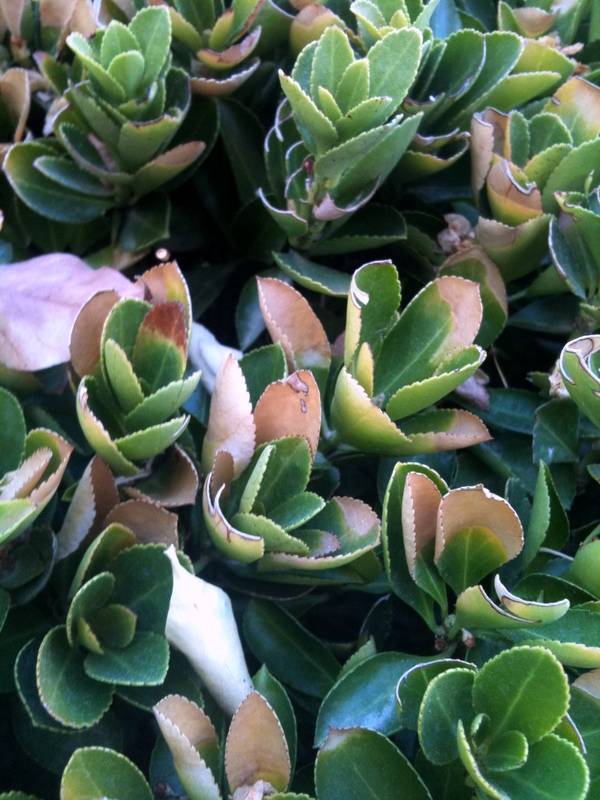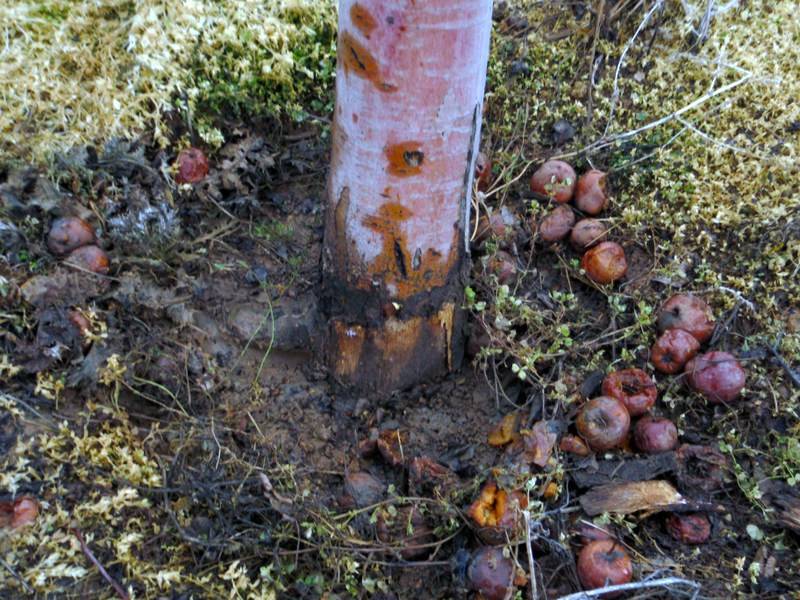Method of pruning makes difference in fruit production


Q: Two years ago I planted Thompson seedless grapes. The first two years there were no grapes, and I did not expect any fruit. This year, there are leaves and no fruit. They were pruned the same way as my red seedless grapes, which were very prolific. Is there something special that I must do to make the vine produce?
A: If the vine is healthy, it is all in the pruning. Thompson seedless might need to be cane-pruned, not spur-pruned like many other grapes. When you cut it back, leave about 8 to 10 inches of last year’s growth and don’t prune it back so hard.
Both Thompson and Black Monukka should be cane-pruned.
Q: What is the best way to get rid of white powdery mildew on my euonymus plants?
A: The best way is without using chemicals. This requires understanding the conditions that create powdery mildew. The conditions that create powdery mildew are high humidity, splashing water, shade and lack of air movement across the leaves. Applying only chemicals circumvents the problem and doesn’t find a long-term solution to the problem.
Make sure your plans are in as much sun as possible. If that is not possible, you might consider a different location for these plants or new ones. Do not let water from sprinklers splash on the leaves.
Prune the plant to create openings for movement of air between the leaves. If there are trees above the plants, consider removing limbs of these trees that are creating too much shade so that more light reaches the plants.
Secondly, if these plants are receiving water from sprinklers, switch to drip irrigation. If these plants are being sprinkled with water accidentally, solve this problem so that the leaves do not receive water from sprinklers.
Prune these plants deep inside their canopy and remove stems that are too close to others and allow more air movement or wind through these plants. As a last resort, you can use the sulfur-based or copper-based fungicides. Fungicides that control powdery mildew on roses should also work.
Q: I read your article in the Sunday Review-Journal regarding the mulching of fruit trees. The article included the comment “Mulch was kept 12 inches away from the tree trunks.” Why was that done? I recently mulched my fruit trees but surrounded the trees with red cedar mulch right up to the trunks.
A: It is kept away from the trunk because of people watering too often. If you are watering frequently, wet mulch against the trunk can cause a serious disease problem called collar rot. Keeping the mulch a short distance from the trunk helps keep the trunk dry.
It doesn’t have to be a foot away. It can be 6 inches away, but 12 inches is easier for most people to gauge. Once the tree is older and the bark is thicker, this is seldom a big problem. But on young trees, I strongly suggest doing it.
Q: I have some stick-sized trees growing very well. Some are about 12 to 18 inches tall. The leaves are around the bottom of the stick and none at the top. Should I cut the stick off down to the leaves?
A: Yes, if you think it’s dead, cut it back to the leaves. When new shoots start to grow taller than 1 foot, remove all but one if you want a single-stemmed tree. If you want a multi-trunked tree, remove all but three or five and leave an odd number growing.
Lightly fertilize it every couple months to push new growth. If this tree is tender to winter freezing temperatures, don’t fertilize after Aug. 1.
Q: I was advised to spray my nectarines and peaches with a garden pesticide containing pyrethrum to kill thrips. Would you still eat the fruit once this chemical has been applied? And if I spray it, will the fruit not be deformed?
A: If the label for this pesticide does not have fruit trees or gardens on the label, then it should not be used for that purpose. This is a legal response, not a technical response to your question.
Nectarines, not peaches, are deformed and scarred mostly because of the feeding damage on the skin of the fruit by Western flower thrips. These insects are tiny, but when there are hundreds of them all feeding on the skin of one nectarine, they rip and tear at this so badly that the fruit becomes deformed and scarred horribly. Killing off the thrips prevents fruit deformity and scarring.
Strangely enough, thrip damage does not occur on peaches, so they will not have to be sprayed. Evidently, the hair on the peach skin is enough to interfere with the feeding damage by these extremely small flying insects.
By the way, thrips are so primitive they don’t have wings like most insects. They have “sticks” that come out of their body with hairs on them. They are very poor fliers and can’t travel very far.
On the label of the pesticide, it tells you how many days you must wait before picking fruit. This is called the “re-entry period” or “days before harvest.”
There is a lot of science that goes into that label. It’s not guesswork. It does not mean that the pesticide is totally gone. It means that a reasonable amount of the pesticide has been degraded by our weather, and the EPA has deemed it safe to eat if the fruit is washed before eating.
As far as the insecticide goes, it is called a synthetic pyrethroid and does a good job killing most insects, including those in the home. However, on thrips, it does not do a great job. Spinosad is much better to use and organic to boot.
But Spinosad is lethal to bees, so spray only when there are no flowers present in the tree or beneath it and bees have gone home for the day. This will be at dusk. Rotate this spray with Neem oil and soap sprays.
Q: How do you stop Gambel’s quail from eating apricot tree leaves? They never touched my 3-year-old tree until near the end of the last growing season, then they swarmed the tree and chewed at everything that was green. They ate all melon plant sprouts yesterday as well. I tried hanging CDs, strips of tin foil to no avail.
A: About the only thing I can suggest is giving them an alternative to munch on or cage them out using bird netting. I am sure there are lots of suggestions from people, such as spraying garlic, hanging pie tins or DVDs to scare them, but in my experience, these tricks do not work for very long or not at all.
Birds can be a real problem, particularly for the fruit. The other option is to let them eat the leaves and let the tree replace what is lost. Once you get past spring, they might move on to other more tender leaves at your neighbors.
Q: You mentioned that citrus trees are often grafted. Are full-size trees grafted like dwarf trees? Do I need to remove anything? The trees are about 5 feet tall. Will I have more success getting fruit from full-size trees?
A: All citrus bought from a nursery are grafted, full-size trees as well as trees sold as dwarf or semi-dwarf. Seldom are they grown on their own roots for a variety of reasons. The most common reason is because of our cold winter climate and protecting the rootstock from freezing. Some of this benefit from freezing is passed on to the rest of the tree.
Fruit produced from dwarf trees can be the same size as standard size trees if the tree is managed properly. If you look at the bottom of the tree, you will see a dogleg where the top tree was grafted to the roots of a different tree. You will see this dogleg on many ornamental trees as well.
Anything growing from below this dogleg (on the rootstock) should be removed as soon as you see new growth. Young trees frequently sucker from this rootstock, and these suckers must be removed. Pulling them off rather than cutting them is better. As the tree gets older, it frequently stops suckering as much.
Enjoy what you can. Citrus is “iffy” in our climate. Some years you will have fruit, other years you will not. Some years they might freeze to the ground and other years sail through the winter without damage.
Bob Morris is a horticulture expert and professor emeritus of the University of Nevada, Las Vegas. Visit his blog at xtremehorticulture.blogspot.com. Send questions to Extremehort@aol.com.













